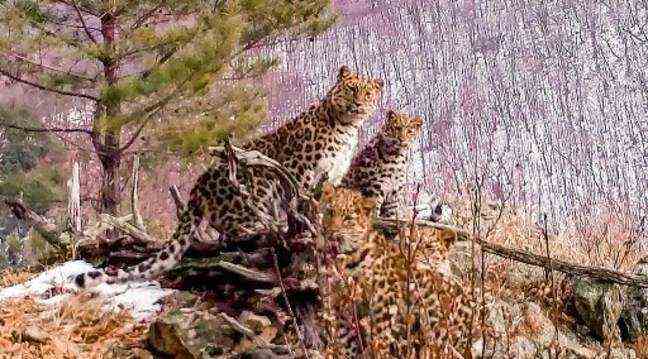A female Amur leopard and her three cubs, the world’s rarest species of big cats, walked past the lens of a camera trap in the Russian Far East. Extremely rare images. – HANDOUT / THE LAND OF THE LEOPARD NATIONAL PARK / AFP
A female Amur leopard and her three cubs, the world’s rarest species of big cats, walked past the lens of a camera trap in the Russian Far East. An exceptional family portrait rewarding the efforts made to save these endangered animals.
The four Amur leopards, named in reference to the river that flows between Russia and China, were filmed in a national park which released these images shot in December on Friday.
The “first litter” for “Leo 117F”
We see the spotted animals standing on a rocky height overlooking a forest. The mother, on the lookout, having perhaps spotted another animal, leaves the frame. Her cubs then observe her calmly, for more than a minute.
According to Ivan Rakov, the spokesperson for the “Land of the Leopards” park, created in 2012 and located in the Russian region of Primorye, this is the first time that this female has been filmed with her offspring.
“We discovered that she was able to raise a family”, rejoices to AFP Yvan Rakov, noting that this is the “first litter” of this mother called “Leo 117F” and whose age is rated at around four years.
According to Yvan Rakov, growing such a large litter in the taiga is no small task: it requires “a lot of space and food”. Amur leopards, renowned for their climbing skills, are considered the rarest big cats in the world and are critically endangered, according to the International Union for the Conservation of Nature.
Back from the dead
In recent years, the measures taken by the Russian and Chinese authorities against deforestation and poaching have made it possible to significantly increase their numbers. Their population is currently estimated at over 100 individuals in Russia, up from around 35 20 years ago. For Ivan Rakov, this leopard, also known as the Amur panther, has therefore “returned from the dead”.
“It’s a great success,” said Alexeï Kostyria, in charge of rare species for the Russian branch of the World Wide Fund for Nature (WWF) in the Amur region. According to him, the creation of protected areas and joint efforts with China have saved the species from poaching which has now “practically” disappeared. For a long time, these leopards were hunted intensively, Chinese medicine ascribing them therapeutic virtues.
“At least 80% of their habitat is now under surveillance”, welcomes Alexeï Kostyria. The expert also specifies that the deer population, a delicacy for felines, has increased in this immense territory which is also home to lynx and tigers.

